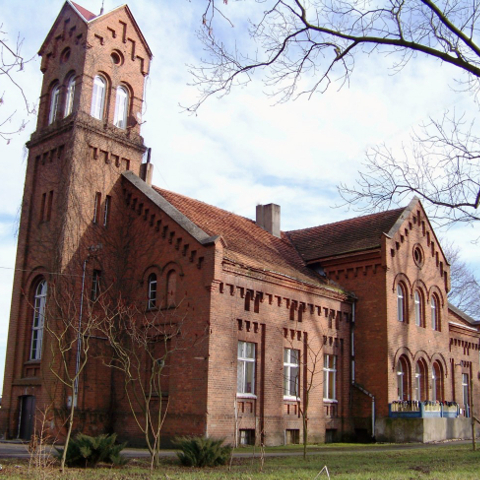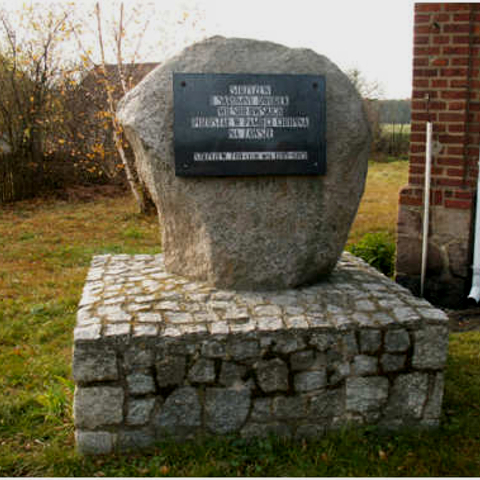Composers / Fryderyk Chopin / Places catalog
Strzyżew
Strzyżew is one of the oldest places in the county of Ostrów (Greater Poland voivodeship). In Chopin’s day, it was part of the Grand Duchy of Posen (Poznań), which belonged to the Prussian partition, and was owned by Stefan Wiesiołowski. In 1820, in Brochów church, Wiesiołowski married Chopin’s godmother, Anna Skarbek, daughter of the owner of Żelazowa Wola. Strzyżew was a refuge for Anna’s father, Count Kacper Skarbek, as it was outside the Russian partition. His riotous lifestyle had driven him into debt, and he had fled to the Grand Duchy to escape his creditors. He spent his final years living with his daughter in Strzyżew, where he died in 1823, aged sixty-two. He was buried in nearby Kotłów cemetery. In 1826, Anna’s brother Fryderyk stopped at the Wiesiołowskis’ on the way to Duszniki. He was travelling with his wife, young son and Chopin’s elder sister, Ludwika. From what he wrote, we know that they also visited Kacper Skarbek’s grave.
Given the distance between Warsaw and Strzyżew, the Chopins had few opportunities to meet the Wiesiołowskis in person. A further impediment, especially when trips were restricted to tight deadlines, was having to procure a passport to travel between the partitions of Poland. Chopin’s sister Ludwika Jędrzejewicz mentioned this in a letter she wrote to him in Paris in 1832: ‘Just imagine: Mrs Wiesiołowska came to Żelazowa Wola and Michał sent for us, but as mother had a sore stomach at the time, and the frost was hard, and father did not have time to get a passport for one day so close to leaving, none of us went. We were really sorry to hear that Mrs Wiesiołowska was doubled up with grief at not seeing us’. Despite these difficulties, the two families remained close, as is confirmed by the fact that Stefan Wiesiołowski was a witness at the wedding of Ludwika Chopin and Józef Kalasanty Jędrzejewicz, held in Brochów church in November 1832. We know that Chopin’s parents paid a visit to the Wiesiołowski estate in the summer of 1829 and took the opportunity to visit nearby Antonin. In 1835, Mikołaj and Justyna Chopin set off for Karlsbad to meet their son. They were assisted by Stefan Wiesiołowski, who made available a coach and harness, and even a servant.
We know from surviving sources that Chopin was planning to visit his godmother in Strzyżew on his way home after giving a successful series of concerts in Vienna in the early autumn of 1829. What we cannot say, however, is whether the visit actually took place. As the Wiesiołowski property adjoined the estate of Prince Antoni Radziwiłł, a great admirer of Chopin, the composer’s godmother almost certainly made the most of this opportunity to promote her brilliant godson. The first few sentences of a letter Chopin wrote to Tytus Woyciechowski on 20 October 1829 leads to this conclusion: ‘I am traveling today at 7 o’clock in the evening by the stagecoach to the Wiesiołowskis in the Poznań region, and that is why I write in advance, especially since I don’t know how long I will stay there, although I took a passport only for a month. My intention is to return in two weeks’ time. Another reason for my trip is the presence of Radziwiłł on his estates near Kalisz’. Chopin remembered Anna Wiesiołowska even after he left Poland in 1830. This is evident from a letter he wrote from Paris in December 1845: ‘I still haven’t set out into the city to do my shopping. I have to find something for my godmother’.
Unfortunately, the Wiesiołowski manor no longer exists. It can only be assumed to have been a typical Polish manor house as described by Kazimierz Włodzimierz Wójcicki: ‘these houses usually had two doors leading to side rooms from a spacious entrance hall. The one on the left led to a large chamber known as the “chancellery”. An ampoule of holy water was hung on the door, and the keys to the granary, coach house, storeroom, cellars etc. were hung on deer horns. There was an open cabinet with shelves and drawers to keep all sorts of domestic accounts and a desk or table for the lord of the manor. […] There was a row of rooms behind the chancellery on this side of the manor. The other side was similarly arranged. There was usually a grand chamber with windows and an exit to the garden in the middle. This served as a salon and drawing room’. We know, from Ludwika Chopin’s description, that portraits of Radziwiłł’s forebears adorned the walls and there was a clavichord, on which Anna Wiesiołowska played. Fryderyk Chopin probably played on it too. If so, he would have more than repaid his host’s generous hospitality. The paucity of information on Strzyżew in Chopin’s day that has survived makes it worth quoting the description of the outstanding Polish ethnographer Oskar Kolberg, who depicts one of the funniest customs of the region: ‘The bride leaves for the church with a large cortege of groomsmen on horseback. The older women sprinkle flaxseed in her slippers so that flax will grow for her. The groom, for his part, takes several types of grain in his boots so as to have good crops. So one half of the future married couple bears responsibility for their being clothed, and the other for their being fed, with God’s help’. Might Chopin have witnessed something like this?
The eclectic manor house, dating from 1870, and the Neo-Gothic Church of Our Lady Queen of Poland, built in 1873–1875, are among the nineteenth-century buildings worth seeing in Strzyżew. There is also a late nineteenth-century school building. In 1995, a statue of Chopin was unveiled next to the primary school, which is named after him. The plaque reads: ‘Chopin never forgot Strzyżew or the humble Wiesiołowski manor. Strzyżew, a 700-year-old village, 1295–1995’.
It is worth noting that the Fryderyk Chopin Museum has pencil portraits of Anna and Stefan Wiesiołowski by Maria Wodzińska, who was at one time Chopin’s fiancée.
-

Anna Wiesiołowska, pencil drawing made by Maria Wodzińska. NIFC collection.
-

Stefan Wiesiołowski, pencil drawing made by Maria Wodzińska. NIFC collection.
-

The eclectic manor house, dating from 1870, phot. Adrian Matys.
-

The plaque commemorating Chopin’s stay at Strzyżewo.